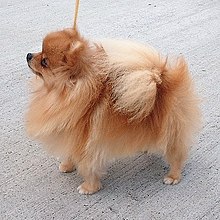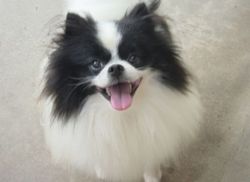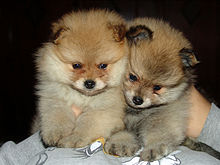Pomeranian dog: Difference between revisions
m Typo & format fix , typos fixed: the the → the using AWB |
→Temperament: Removed those last few statements; Original research. |
||
| Line 64: | Line 64: | ||
[[Image:Pomerania REFON.jpg|thumb|220px|right|Puppies]] |
[[Image:Pomerania REFON.jpg|thumb|220px|right|Puppies]] |
||
They make excellent watch dogs and will sound a bark when they sense danger. The Pomeranian is lively and eager to learn. They get along well with other household pets if given a slow and proper introduction. They make wonderful companions for families with older, well-behaved children and the elderly. |
They make excellent watch dogs and will sound a bark when they sense danger. The Pomeranian is lively and eager to learn. They get along well with other household pets if given a slow and proper introduction. They make wonderful companions for families with older, well-behaved children and the elderly. |
||
The Pomeranian is a very sweet dog who adores spending time on laps or running around |
The Pomeranian is a very sweet dog who adores spending time on laps or running around. |
||
The Pomeranian breed has a wide variety of personalities. Some will have the previous-described nature but many are the exact opposites. People tend to shy away from Poms due to descriptions like these. The truth is many Poms have a laid back and relaxed nature, excellent with children, and never bark! When purchasing a Pom the main thing to remember is always meet and greet before purchase. If the puppy makes any type of noise it will be a barker. |
|||
== Health == |
== Health == |
||
Revision as of 20:51, 24 October 2007
| Pomeranian | |||||||||
|---|---|---|---|---|---|---|---|---|---|
 An orange Pomeranian | |||||||||
| Other names | Deutscher Zwergspitz
Toy German Spitz Zwers | ||||||||
| Common nicknames | Pom | ||||||||
| Origin | Germany | ||||||||
| |||||||||
| Dog (domestic dog) | |||||||||
The Pomeranian is a breed of dog in the spitz family, named for the Pomerania region of Historical Eastern Germany, which is today part of northern Poland and part of modern eastern Germany, and classed as a toy dog breed because of its small size. As determined by the FCI the Pomeranian is part of the German Spitz breed, and in German and many foreign speaking countries known as the Zwergspitz, or Toy German Spitz.
History
The Pomeranian originated from the sled dogs of Greenland and Lapland, which were eventually brought into Europe in Pomerania. This region, bordered on the north by the Baltic Sea, has been under the control of Slavs, Swedes, Danes, Germans, and Prussians, at various times, and most recently Poles. This region extends from the west of the Rügen Island to the Vistula River. The name Pomore or Pommern, was given to the district about the time of Charlemagne, and comes from the Latin Longum Mare ("along the sea".) Breeders in Pomerania improved the coat and bred the dogs down for city living, but they were still 2 pounds or more when they reached England.
English breeders, through trial and error and Mendelean theories, are credited for reducing the dog's size and developing the many colors. The Pomeranian of today is small due to selective breeding, but the breed still retains the hardy disposition and thick coat typical of dogs in cold climates.

Queen Charlotte first introduced the Pomeranian to English nobility, however; the Pom gained international popularity when her granddaughter Victoria returned from vacation in Florence, Italy with a Pomeranian named Marco.
The dogs owned by Queen Charlotte & Queen Victoria were much larger and were German Spitz and a Volpino Italiano. The same is true of any other historical Pom from before the 19th century.
The FCI classifies the German Spitz as one family consisting of the Dwarf (Pomeranian), Small and Standard (American Eskimo Dog), and Wolfsspitz (Keeshond). Additional close relatives of the Pomeranian are the Norwegian Elkhound, the Schipperke, and possibly the Samoyed.
Appearance
At an average of 3 to 7 lb (1.4 to 3.2 kg) according to AKC standards, the Pomeranian (Pom) is the most diminutive of the northern breeds.
The head of the Pomeranian is wedge-shaped, making it somewhat foxy in appearance. The ears are small and set high. Its tail is characteristic of the breed and should be turned over the back and carried flat, set high. When born, the tail is not spread out; it may take months for it to grow over the Pomeranian's back, and flatten. Beneath the Pomeranian's fur is a small but muscular dog, similar in appearance to a Chihuahua (dog).
The Pom's coat is its glory, two coats, an undercoat and a top coat; the first is soft, thick, and fluffy; the latter is long, straight and coarse. The undercoat is shed once a year by males, by intact females when they are in season, after delivering a litter, and during times of stress.

The AKC recognizes thirteen colors or color combinations: black, black & tan, blue, blue & tan, chocolate, chocolate & tan, cream, cream sable, orange, orange sable, red, red sable, and sable. The dogs that have 2 or more colors (usually mostly white, with others), are called "Parti-Color".
The AKC also recognizes five "alternative" colors: Beaver, brindle, chocolate sable, white, and wolf sable.
One breed standard calls for a cobby, balanced dog. A cobby dog is as long or shorter than it is tall; try to picture it as a circle in a square. A balanced Pomeranian fits together logically and in proportion. For instance, a small, delicately boned Pom with a large head looks unbalanced because its head type doesn't match its body type. A balanced Pom displays legs in proportion to its body: neither so short as to make him appear dumpy nor so long as to make it look like he is walking on stilts.
This standard also calls for an expression that imparts great intelligence, showing that the Pom has an alert character and that he behaves accordingly. The Pom's alertness makes it a superb watchdog, and a great companion, However they are very feisty and stubborn at times (they need a lot of attention).
Temperament
The Pomeranian is a very active dog who is intelligent, courageous, and a loyal companion. Pomeranians enjoy walking, and are fit for apartment life. They can be trained to be good watchdogs. The Pomeranian is confident, commanding, and outgoing. Due to the Pomeranian's small stature, they are not recommended for homes with small children as they may become temperamental.

They make excellent watch dogs and will sound a bark when they sense danger. The Pomeranian is lively and eager to learn. They get along well with other household pets if given a slow and proper introduction. They make wonderful companions for families with older, well-behaved children and the elderly. The Pomeranian is a very sweet dog who adores spending time on laps or running around.
Health
Pomeranians are generally a healthy, hardy, and long-lived breed. Poms often live 12–16 years. Some very healthy Poms have even been known to live 18-20 years.
The most common problem in Pomeranians is luxating patella. Also Legg-Calvé-Perthes syndrome and hip dysplasia can occur, but are rare in this small breed. Patent ductus arteriosus (a congenital heart defect) and collapsing trachea have become serious problems in Poms.

Dry eye, tear duct disorders and cataracts that can appear in young adulthood and often lead to blindness are also common. Skin diseases are quite common, especially allergies (that often leads to acute moist dermatitis or "hot spots") and follicular dysplasia (also known as alopecia X). Other problems that occur regularly include hypothyroidism, epilepsy, and hypoglycemia. Occasionally, hydrocephalus can occur in Pom puppies. Poms, like many toy breeds, are prone to bad teeth and harmless episodes of reverse sneezing. Also, it is important that Poms are trained not to mingle around peoples feet. Because of their loyal tendencies, they will follow from room to room, easily getting stepped on. Their delicate bodies will injure easily this way.
Grooming

Coat care for the Pomeranian is similar to the Pekingese. A daily or twice weekly (damp) brushing against the hair weekly is essential to keep the thick, plush coat, which sheds seasonally, free of mats. Brushing also helps to prevent dry skin and dandruff. A Pomeranian's coat needs very little trimming only every now and then. Combing is seldom necessary and sometimes totally unnecessary. Regular ear and nail care is recommended, along with generally only peak-seasonal bathing. It is unadvisable to bathe Pomeranians too frequently as excessive bathing can damage their skin and coat by removing essential oils, especially if using anti-flea products. Pomeranians are also prone to teeth problems, and it is recommended that their teeth be brushed at least once a week. Ideally, their teeth should be brushed daily and the dog receive dental and vitamin treats.
Historical Owners
- Michaelangelo had a Pomeranian who would sit and watch him paint the Sistine Chapel.
- Queen Victoria had 2 Poms.
- Sir Isaac Newton had a Pomeranian who once upset a candle on his important papers, which contained more than 20 years of research.
- Sharon Osbourne has 3 Pomeranians named Minnie, Mr Chips and Pipi.
- Paris Hilton has 1 Pomeranian named Prince.
- Nicole Richie has a Pomeranian named Foxy Cleopatra.
- Ice skater Sasha Cohen has a Pomeranian named Mocha.
- Maria Sharapova has a Pomeranian named Dolce.
- Fran Drescher had a Pomeranian named Chester who was featured on her show, The Nanny, as C.C.'s pet.
References
- Many people (2005). The Dog Bible. Bowtie Press. ISBN 1-931993-34-3.
- Spirer, Louise Ziegler; & Spirer, Herbert F. (1965). This is the Pomeranian. TFH Publications. ISBN 0-87666-354-4.
{{cite book}}: CS1 maint: multiple names: authors list (link) - Liebers, Arthur; & Sheppard, Georgia M. (1959). How to Raise and Train the Pomeranian. TFH Publications. ISBN 0-87666-352-8.
{{cite book}}: CS1 maint: multiple names: authors list (link) - Tietjen, Sari Brewster (1989). The New Pomeranian. Howell Book House. ISBN 0-87605-251-0.
